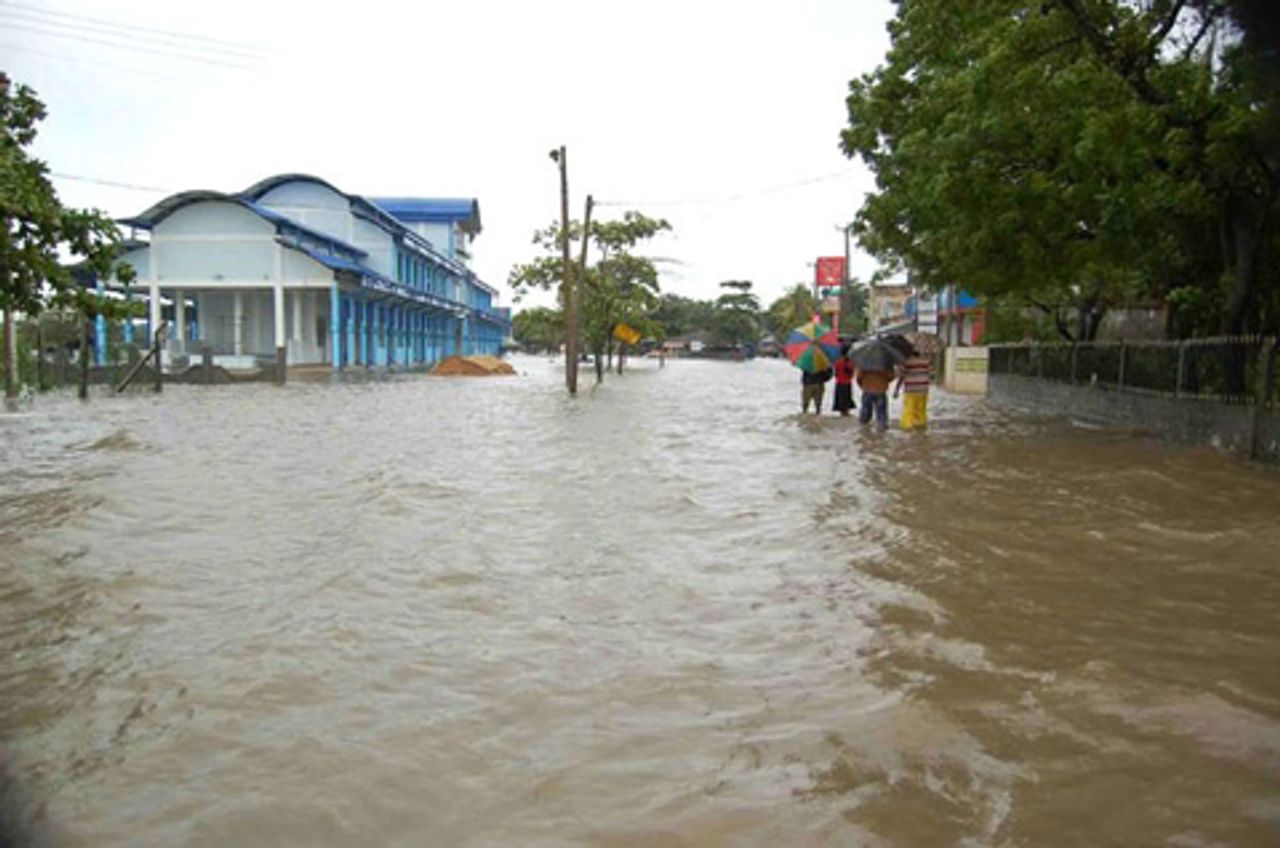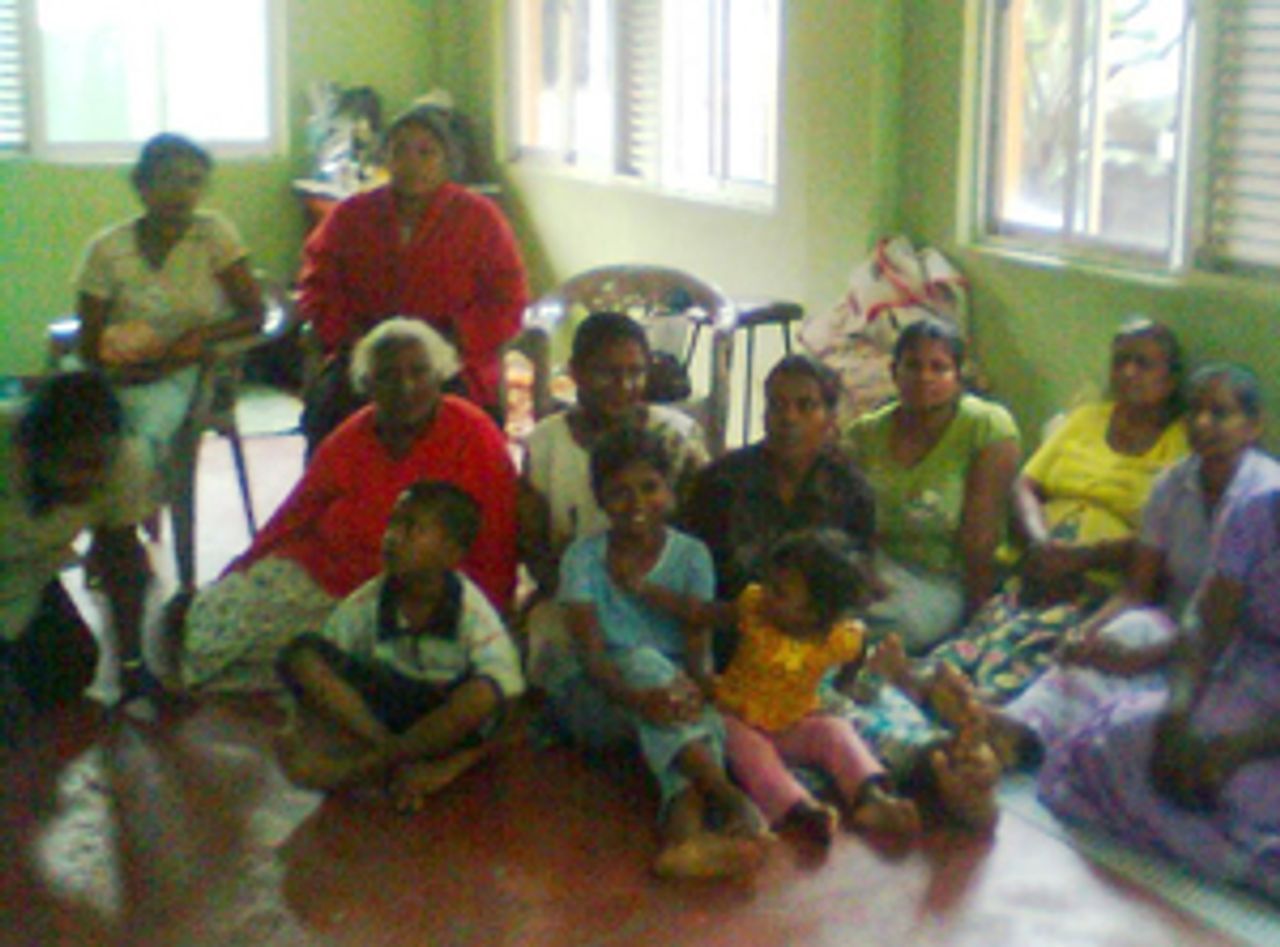Severe flooding caused by more than two weeks of torrential rains has affected more than one million people in 12 districts of Sri Lanka. More than 350,000 people have been forced to leave their homes and are having to shelter in makeshift camps set up in government buildings, schools and temples, without adequate supplies of food, clean water and medicines. As of yesterday, the official death toll stood at 23, mostly as a result of mudslides.
The worst affected areas are the eastern districts of Batticaloa and Ampara, which have already been ravaged by decades of civil war and were badly hit by the 2004 tsunami. Nine villages are completely cut off by floodwaters and can be reached only by sea. Tens of thousands of people in those areas are in need of food and medical supplies. Railways and roads are under water, further disrupting transport and the provision of supplies.
 Flooding in Batticaloa town
Flooding in Batticaloa townAccording to the government’s Disaster Management Centre, nearly 870,000 people have been affected by flooding in the Batticaloa and Ampara districts alone. Some 25 of the 200 evacuation camps have been inundated, forcing displaced people to move again. Thirteen deaths have been reported in the Batticaloa district and about a dozen people are missing.
Seven hospitals in Batticaloa have been flooded, posing serious public health threats. Batticaloa Teaching Hospital director Dr. K. Murugananthan told the media there was shortage of basic drugs, including paracetamol and antibiotics, at his hospital. “We can expect diarrhoea patients and snake bite victims. But, it is difficult for patients to reach the hospital. It is still raining heavily,” he said.
The Department of Meteorology has explained that as well as the normal monsoons, the country is being affected by the same regional La Niña weather pattern that has caused heavy flooding in north-eastern Australia. While the eastern districts of Sri Lanka have been particularly hard hit, large areas of the island have also been affected and further flooding could take place. In all, 1,727 houses have been completely destroyed and 12,151 houses partially damaged.
R. M. S. Bandara, who heads the Land Slide Division of the National Building Research Bureau, has warned that 10 of the country’s 25 districts are vulnerable to land- and mud-slides. The most common causes of landslides are deforestation and the building of houses on the sides of hills, due to the lack of land and proper government planning.
On Saturday, seven people, including two children, were killed at Gatambe near Kandy in the central hill district, when a huge stone crushed seven small houses. The victims, along with other poor families, had been living in an abandoned quarry for decades because they had no land or alternative accommodation. Their homes were small huts built with planks or cement bricks. The survivors have been transferred to a community centre. Landslides have been reported from several other areas near Kandy.
The heavy rain and flooding have damaged major areas of crops. In a number of areas, including the Anuradhapura and Polonnaruwa districts in North Central Province, large irrigation tanks, or reservoirs, have burst their banks, inundating surrounding farms. At least 15,000 hectares of crops have been destroyed and another 90,000 hectares of farming land is under water. Poultry and livestock farms have been devastated.
The Agriculture Ministry estimates that at least 21 percent of Sri Lanka’s rice crop has been destroyed, but the loss could be as high as one third. The losses will inevitably compound already steep price rises for rice and other food. Caritas aid official George Sigamoney told CNN: “The poor will find it even more difficult to afford the most basic food items.”
The government’s response to the disaster has been completely inadequate. The lack of basic civilian services has been underscored by the large-scale mobilisation of the military to provide basic rescue and relief. International agencies have supplied some essential items, including food, water purification tablets, hygiene kits and sleeping mats.
Disaster Management Minister Mahinda Amaraweera announced on Tuesday that the government had allocated 25 million rupees ($US227,000) in immediate relief for the Batticaloa district and another 25 million rupees for other districts. With a million people affected, that translates into a pitiful 50 rupees, or 45 US cents, per head.
Speaking on Wednesday in the Polonnaruwa district after touring flood-affected areas, President Mahinda Rajapakse urged public servants to ignore circulars and take their own initiatives, but did not say how or where the money for such initiatives would come.
 Landslide victims sheltering at Kandy refuge
Landslide victims sheltering at Kandy refugeThe latest 2007 circular from the Ministry of Resettlement and Disaster Relief Services is preoccupied with limiting spending on disaster relief. It stipulates that the weekly provision of basic dry rations—rice and lentils—is set at 245 rupees ($US2.05) for a single person and 525 rupees ($US4.06) for a five-member family.
The maximum compensation for a house that has been completely destroyed is 50,000 rupees and for a partially damaged home it is 25,000 rupees. Assistance for damage to a farmer’s house and crops is limited to 50,000 rupees, and for the destruction of a self-employment project the limit is 20,000 rupees. Even at 2007 prices, these amounts are totally inadequate.
The broader issues have been buried by the government and the media. Monsoonal flooding occurs regularly in different parts of Sri Lanka, yet successive governments have failed to take any preventative steps, including the proper maintenance of tanks and reservoirs and the planning of cities, towns and villages.
The Rajapakse government restarted the war against the Liberation Tigers of Tamil Eelam (LTTE) in mid-2006 and vastly expanded the military budget at the expense of essential physical and social infrastructure. Since the LTTE’s defeat in 2009, the government has begun to implement the austerity measures required by the International Monetary Fund, imposing new burdens on working people. Disaster prevention and relief have been very low priorities.
People spoke to the WSWS about the inadequacy of the government’s relief efforts. S. Nathan, whose house in Batticaloa is surrounded by water, said: “I don’t know how long it will take to return to normal. Until then we have to starve, as what we had at hand has run out. People in refugee camps don’t get enough food relief, despite what is claimed by government authorities. While people are in a pathetic situation, the politicians are enjoying rides in helicopters and boats to visit flooded areas.
“Many people here are poor farmers or fishermen. They have nothing. We faced 30 years of [civil] war that devastated our conditions. We have also faced the tsunami in 2004 when many their lost lives and property. Many of those tsunami-affected people did not get houses from the government. Others have only been able rebuild half of their homes with government aid.”
Shamila from Kalmunai told the WSWS: “We are living amid the flood. Part of our partially constructed new home is above the water level, so we are living there. The present cold weather will make us sick and we have no way to get to health care facilities.
“It is always announced that the affected people are provided with relief but we have not been given assistance. We lost everything in the tsunami, including several family members. It was only with the help of well-wishers that we have survived up to now.”
